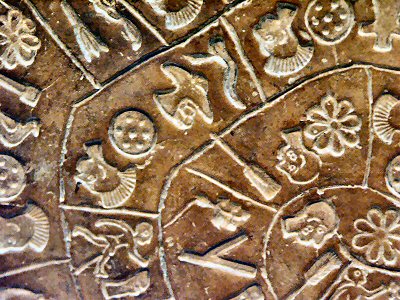
Another top ten today - there's a fun blog post over on Beauty of Earth, with a list of the ten most famous uncracked codes. They range from Kryptos, a 1990 sculpture installed in the grounds of the CIA in Langley, Virginia, to Linear A, one of two linear scripts used in ancient Crete. (The other script, Linear B, was deciphered in 1952 by a British architect called Michael Ventris, when he showed that it was used to write Greek. Reading about Ventris's work was what inspired a young London schoolboy called Michael Wright to find a mystery of his own to solve. Decades later, he went on to decode the Antikythera mechanism.)
It's an intriguing list, although the reason that some of the codes have never been cracked may well be because they are meaningless hoaxes. Unfortunately it's impossible to know which! One entry that has been called into question recently is the Phaistos Disc. This flat disc of fired clay is stamped on both sides with an uneven spiral pattern of mysterious pictographic symbols. It was found in 1908 in the Minoan palace of Phaistos in Crete, alongside remains dating from around 1700 BC. Because of the way the symbols were stamped into the clay, it has been described as the earliest ever example of movable type.
But no one has ever been able to decipher the symbols. And last summer, Jerome Eisenberg, a specialist in faked ancient art, published an article in the magazine Minerva arguing that the disc was fired too perfectly to be authentic. He reckons that the Italian archaeologist who supposedly found it, Luigi Pernier, may have faked the disc because he was desperate to unearth something at Phaistos that would outdo the fabulous artefacts that his rival, Sir Arthur Evans, was discovering at the nearby site of Knossos.
Plenty of enthusiasts are still convinced that the disc is real, though, and I for one really hope that it is. The mystery could be solved by a technique called thermoluminescence dating, which would give a rough date for when the object was last fired. Unfortunately the authorities at the Heraklion Museum, where the disc is held, have apparently refused permission for this to be done. The test involves heating a sample of the object, so they may be concerned about damaging such a precious artefact. Or perhaps they know something we don't.